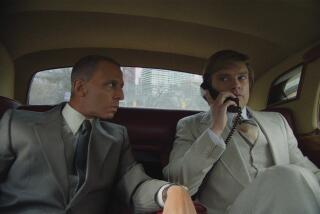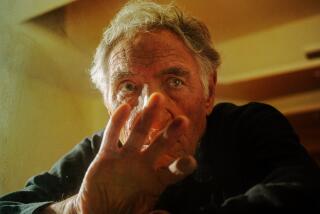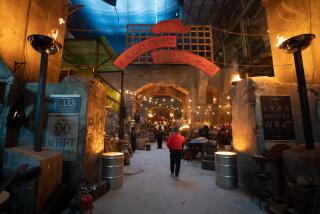MOVIES : Twofers in a Brooklyn Smoke Shop : While filming ‘Blue in the Face,’ director Wayne Wang got the idea to recycle the talent for the improvised ‘Smoke.’ The actors loved it, but audiences may be confused.
- Share via
It’s not a mix-up in the pro jection room. And it’s the right theater. But a trailer for the upcoming Miramax drama “Blue in the Face” has left some moviegoers wondering if they aren’t, in fact, being shown a preview of the film they’ve paid to see: the Miramax drama “Smoke.”
Both “Smoke” (playing in 100 theaters nationwide) and “Blue in the Face” (opening in October) are set in a Brooklyn cigar store and celebrate the borough. In both films, Harvey Keitel is the amiable proprietor Auggie Wren, who functions as salesman, confidant and friend to his customers.
The two films are the brainchildren of director Wayne Wang (“The Joy Luck Club,” “Slamdance,” “Eat a Bowl of Tea”) and novelist Paul Auster (“Mr. Vertigo,” “Leviathan” and “The Music of Chance”).
But significant differences exist between the two movies, which had their world premieres in February at the Berlin Film Festival, with “Smoke” winning the special Jury Prize.
“Smoke”--directed by Wang and written by Auster--stars William Hurt, Harvey Keitel, Stockard Channing, Harold Perrineau Jr., Ashley Judd and Forest Whitaker. The film charts chance encounters of people hanging around a Brooklyn smoke shop and, eventually, some of their lives become intertwined.
“Blue in the Face” came about almost as an afterthought. It was shot for less than $2 million in just five days right after the $10-million “Smoke” wrapped its 50-day shooting schedule.
“Blue” is an improvisational work--the screen credit says “Situations created by” Wang and Auster--consisting of 12 scenarios, each 10 minutes long.
“It’s the flip side of ‘Smoke,’ ” says “Blue” co-producer Peter Newman (“Swimming to Cambodia”), also a co-producer for “Smoke.” “Whereas the first is a writer’s movie, ‘Blue’ is totally improvised. It’s still about the same things--about people from all walks of life . . . coming through the smoke shop.”
Wang actually hit upon the idea for “Blue” while filming “Smoke.”
“While we were rehearsing, I kept feeling that we’ve got to do something with all these wonderful actors who have got small parts,” he says. “I was constantly feeling, ‘There’s a lot of energy and talent. Why aren’t we doing something more with them?’ ”
Wang easily convinced Auster and Newman. Miramax jumped at the chance, too, as did actors who relished the idea of being able to improvise on camera--and not having to endure endless retakes.
“The first take was put on film in every instance,” Wang says, noting that by doing so you capture “real energy and real drama.” “If you redo a scene, it’s a little different already.”
In addition to Keitel, actors in “Smoke” who also are in “Blue” include Mel Gorham (Auggie’s girlfriend, Violet), Steve Gevedon, Jose Zuniga and Giancarlo Esposito as off-track betting enthusiasts, and Jared Harris (as Auggie’s slow-witted assistant).
Counterculture types such as John Lurie, Jim Jarmusch and Lou Reed came on board. So did stars such as Roseanne, Michael J. Fox, Lily Tomlin and Madonna, who all worked for scale and shared makeshift facilities for hair, makeup and wardrobe.
Tomlin plays a homeless man dying to get enough money for some Belgian waffles. Fox portrays a somewhat wacky pollster/cult member who carries cheese and chocolate drinks in his briefcase. Roseanne is the cigar-shop owner’s bored, unhappy housewife, who yearns for another kind of life in Las Vegas. Jarmusch smokes what he claims is his last cigarette. A flamboyant Madonna exuberantly delivers a singing telegram. And Reed offers monologues attesting to his love of Brooklyn.
Wang jokingly calls “Blue in the Face” “the other bad brother.” “It was a chance for people to literally go crazy--to sort of lose their minds for a couple of days.”
According to Wang, “Blue” afforded the actors and filmmakers a chance to be impulsive, to indulge in outrageous humor and to talk until they were “blue in the face.”
“This was a chance to make a funny movie on the fly,” Wang says. “It’s my tribute to Roger Corman. He would always shoot three movies using the same set, the same time and almost the same costumes. I don’t see why people don’t do that more often.”
Recently, at the Music Hall theater in Beverly Hills, the trailer left some patrons confused.
“My first reaction was to go tell the people working here that they’re ruining the movie by showing us the trailer for the movie we’re about to see,” said rock musician Josh Gordon. “I was very close to getting up and saying, ‘What are you people doing?’
“Then, three-quarters of the way through it, I realized William Hurt and Forest Whitaker were nowhere to be seen, and I realized that this was probably some strange sequel.”
“I was angry,” chimed in his companion, Melissa Chappell, a director at the Christopher Grimes Gallery in Santa Monica. “We were poking each other.”
Laura Ornest, a free-lance news producer who’s currently working on the O.J. Simpson trial for CNN, also mistakenly assumed that the “Blue” trailer was “Smoke.”
“I thought they really messed up. I knew Harvey Keitel was in the movie, and I knew it was about a smoke shop. But then the trailer started to get confusing. They showed Madonna and Lily Tomlin. . . . I was a little indignant, actually. It was one of the most unusual things I’ve ever seen.”
Wang says he’s surprised that the trailer has baffled viewers. “It shouldn’t be that confusing. I hope that doesn’t happen a whole lot. They should just relax and know that the trailer they’re seeing is in a way related to the movie they’re seeing.”
Now, plans are afoot for more “Smoke” sequels. “We’re going to try to make this a yearly thing,” Wang says. The next? “White Between the Eyes.”
More to Read
Only good movies
Get the Indie Focus newsletter, Mark Olsen's weekly guide to the world of cinema.
You may occasionally receive promotional content from the Los Angeles Times.










